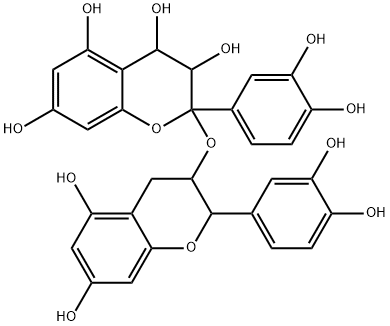20347-71-1
 20347-71-1 結(jié)構(gòu)式
20347-71-1 結(jié)構(gòu)式
基本信息
chroman-3,4,5,7-tetraol
-5,7-dihydroxychroman-3-yl)
-2-((2-(3,4-dihydroxyphenyl)
2H-1-Benzopyran-3,4,5,7-tetrol, 2-(3,4-dihydroxyphenyl)-2-[[2-(3,4-dihydroxyphenyl)-3,4-dihydro-5,7-dihydroxy-2H-1-benzopyran-3-yl]oxy]-3,4-dihydro-
物理化學(xué)性質(zhì)
常見問題列表
Proanthocyanidins are present in plants as complex mixtures of polymers. Predominant food sources are red wine, tea, chocolate and fruits like grapes, apples, pears, and cranberries.
The most interesting antibacterial activity of Proanthocyanidins is related to their presence in cranberries (
Vaccinium macrocarpon
Ait.). A number of clinical trials have demonstrated the effectiveness of cranberry consumption in preventing urinary tract infections (UTIs). Although UTIs can be caused by many microorganisms, more than 85% are caused by Escherichia coli. The presence of P-fimbriae on
E. coli
, which are proteinaceous fibers on the bacterial cell wall, has been clearly established as a virulence factor, since they are responsible by producing adhesions for adherence to uroepithelial cells. Recently, it is demonstrated that cranberry Proanthocyanidins might inhibit P-fimbriated
E. coli
from adhering to uroepithelial cells. The antiadhesion activity of cranberry juice appears to be related to the presence of Proanthocyanidins with at least one A-type linkage.
The effects of cacao liquor Proanthocyanidins on 2- amino-1-methyl-6-phenylimidazo [4,5-b] pyridine-induced mutagenesis in vivo carcinogenesis in female Sprague-Dawley rats are investigated. In the Ames assay, Proanthocyanidins shows strong antimutagenic effects when assayed in the presence of S-9 mixture. They also inhibit significantly rat pancreatic carcinogenesis in the initiation stage, but not mammary carcinogenesis.